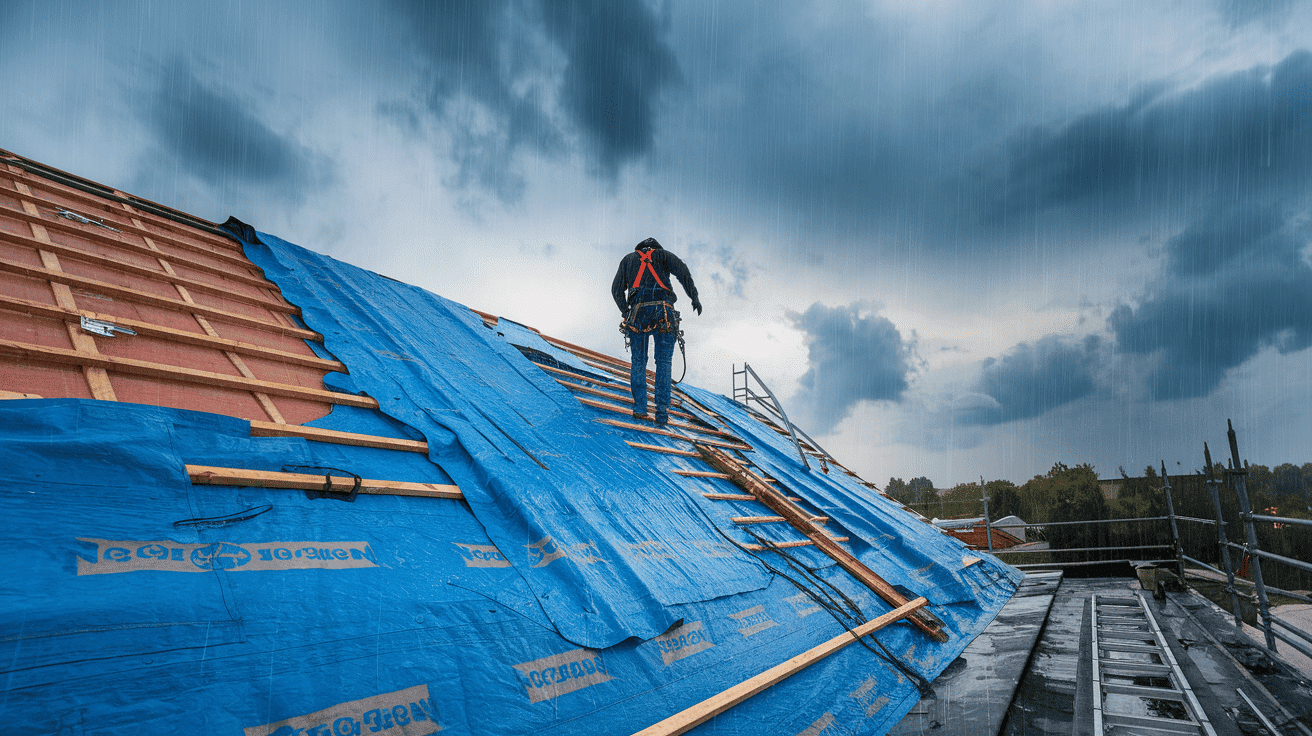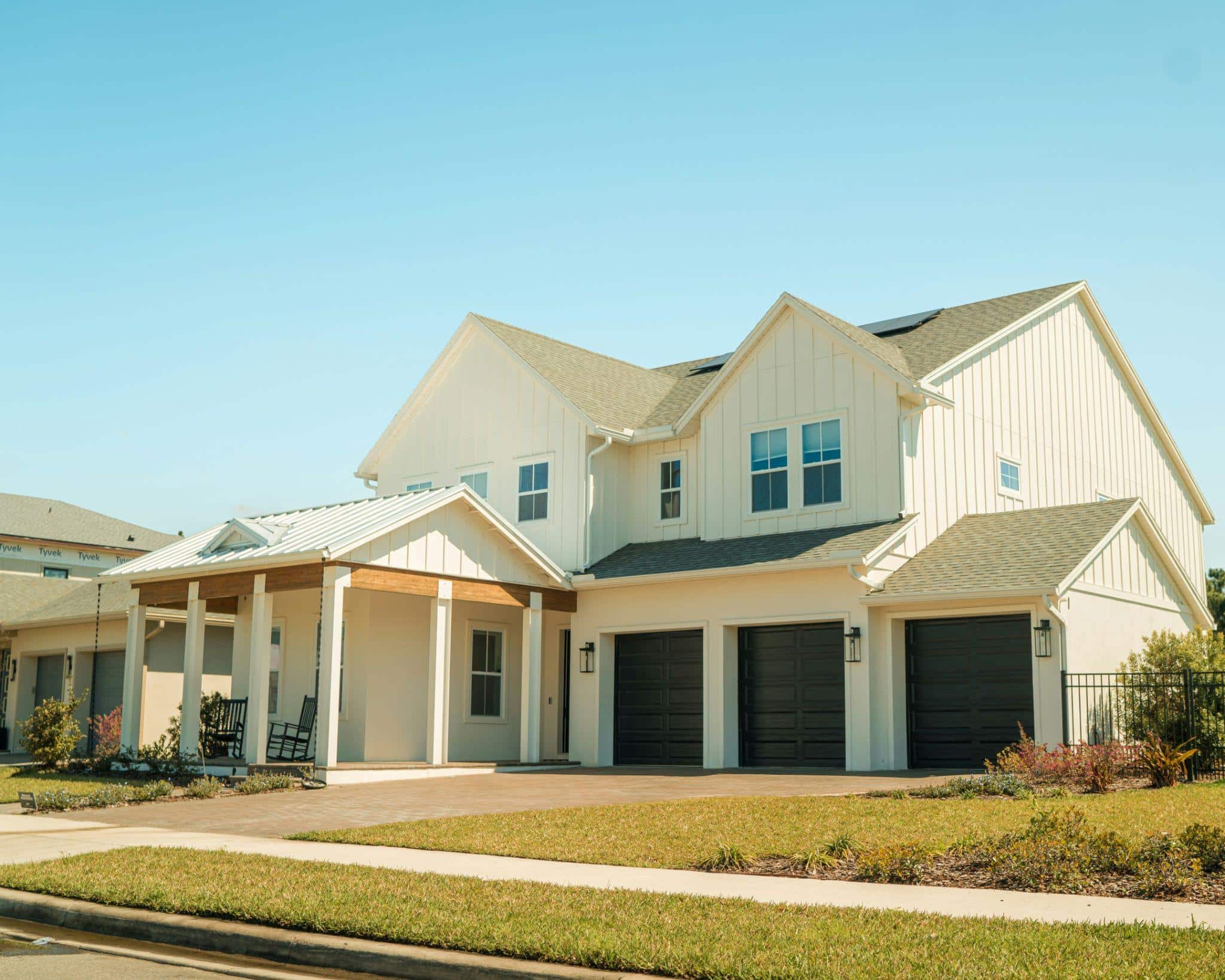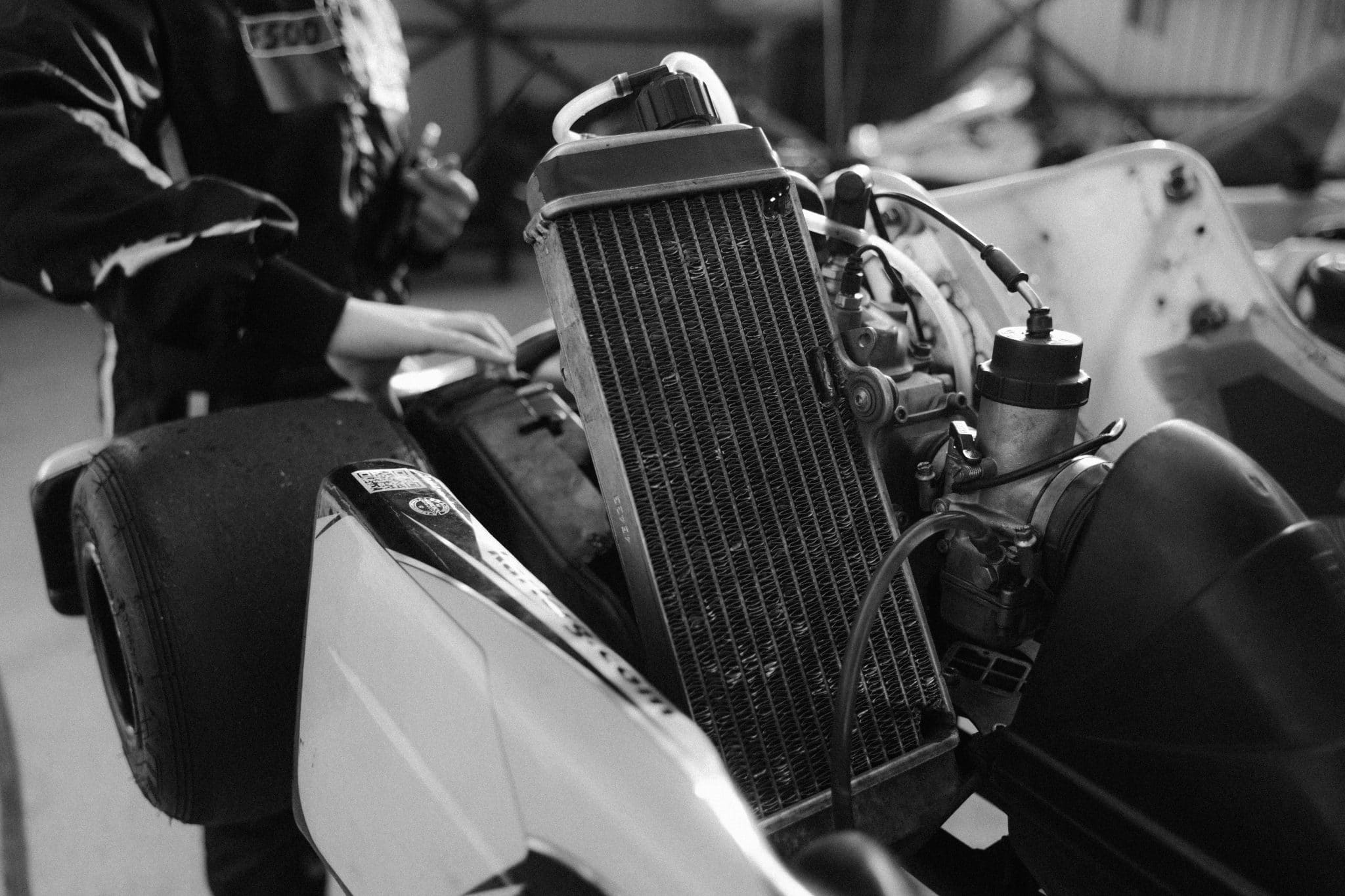I’ve seen too many homeowners panic when dark clouds roll in during their roof replacement project. Rain during roofing isn’t just inconvenient – it can turn your home improvement dream into a costly nightmare.
Water damage to exposed decking, ruined materials, and safety hazards are just the beginning.
However, here’s what most people don’t know: professional roofers have specific protocols in place to handle rain emergencies.
I’m going to share the exact steps contractors take to protect your home and what you should do as a homeowner.
In this guide, I’ll walk you through the immediate actions roofers take when rain hits, the protective measures they use, and how you can prepare your home for weather delays during roof installation.
What Happens If It Starts Raining Mid-Installation?
Rain can hit unexpectedly during roof work. Professional roofers have clear protocols to handle these situations quickly and safely.
1. Immediate Actions
Roofers stop all work the moment it begins to rain. Teams quickly cover exposed areas with tarps and waterproof sheeting. Workers secure loose materials and tools to prevent them from blowing away.
All electrical equipment gets unplugged and moved to dry areas. The crew evacuates the roof safely using proper ladder procedures.
2. Post-Rain Assessment
Once the rain stops, contractors inspect the entire work area carefully. They check for water damage to exposed decking and structural elements. Teams examine materials, such as shingles and underlayment, for moisture problems.
Any wet insulation gets replaced before work continues. Workers also test that all surfaces are completely dry and safe for installation.
3. Communication with Homeowners
Contractors contact homeowners immediately when rain delays occur. They explain what protective steps were taken to secure the property. Teams provide updated timelines for when work can resume safely.
Homeowners receive regular updates about weather conditions and project progress. Good contractors also document any weather-related issues for insurance purposes.
4. Recovery Steps
When the weather improves, allow complete drying time before resuming roofing work. Replace any wet materials, such as shingles or underlayment, that have absorbed moisture. Inspect all surfaces, scaffolding, and equipment for safety and stability before proceeding.
Resume work only when conditions are entirely safe. Wet surfaces create slip hazards, and compromised materials lead to poor installation. Proper assessment prevents accidents and ensures the quality of the project.
Quality contractors never rush back to work after rain. They prioritize safety and proper installation over speed to ensure your roof performs well for years to come.
The Risks of Roofing in the Rain
Working on roofs during wet weather creates serious problems for homeowners and contractors. Here are the main risks to consider:
1. Water Damage
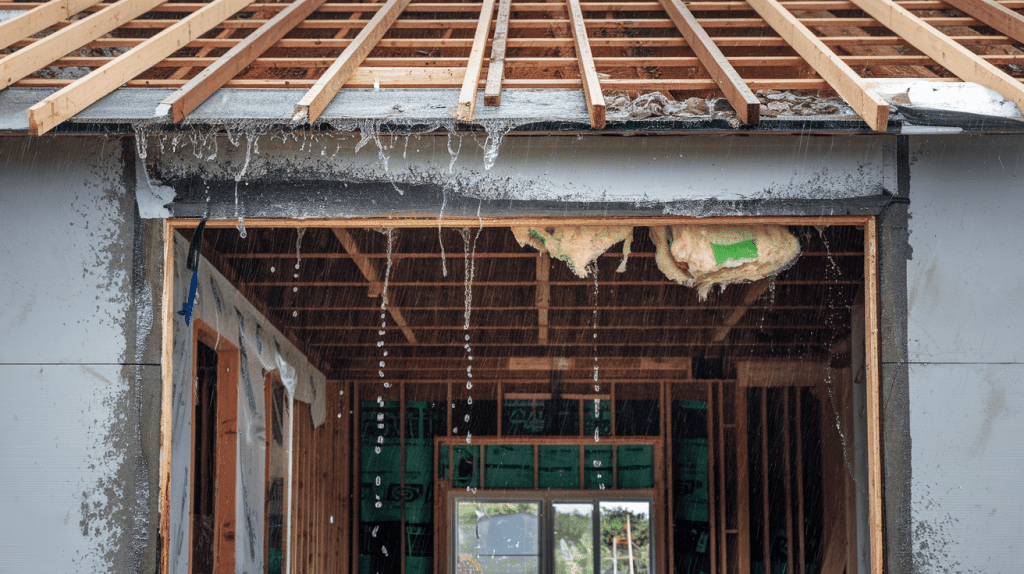
Rain can soak into exposed roof decking. This moisture leads to:
- Mold growth inside your home.
- Wood rot in structural beams.
- Damage to insulation materials.
- Costly repairs later.
2. Material Problems
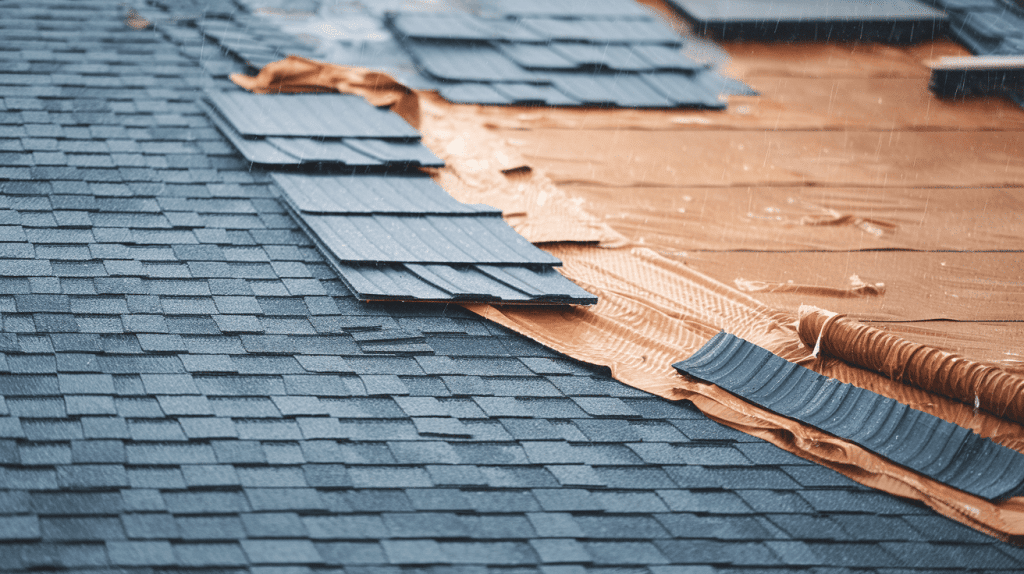
Wet conditions affect roofing materials badly:
- Shingles won’t stick properly to damp surfaces.
- Adhesives lose their bonding strength.
- Tar and sealants don’t cure correctly.
- Your new roof may fail sooner.
3. Safety Risks
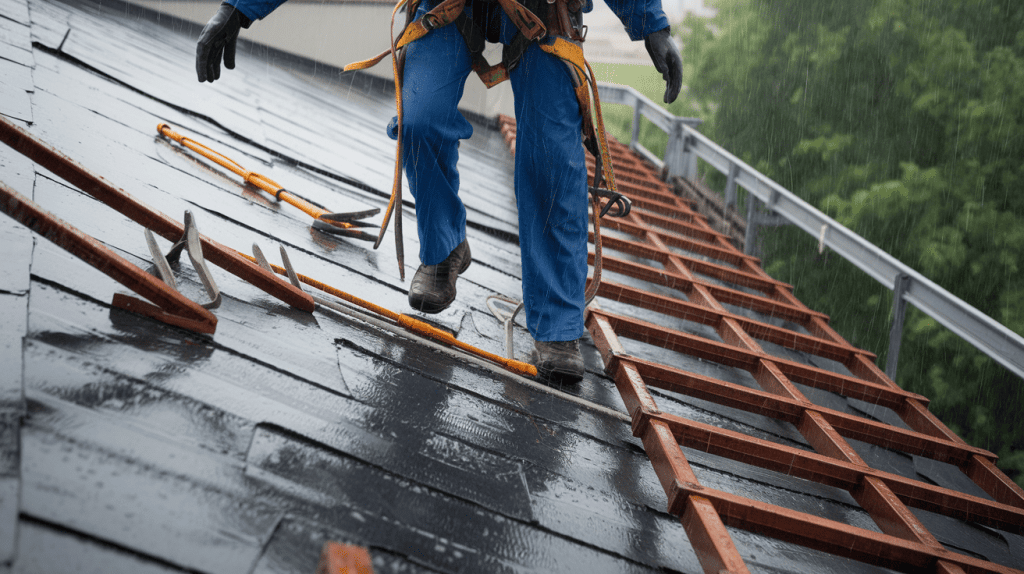
Rain makes roofing work dangerous:
- Slippery surfaces cause falls.
- Workers can’t grip tools properly.
- Ladders become unstable.
- Emergency response takes longer.
4. Project Delays
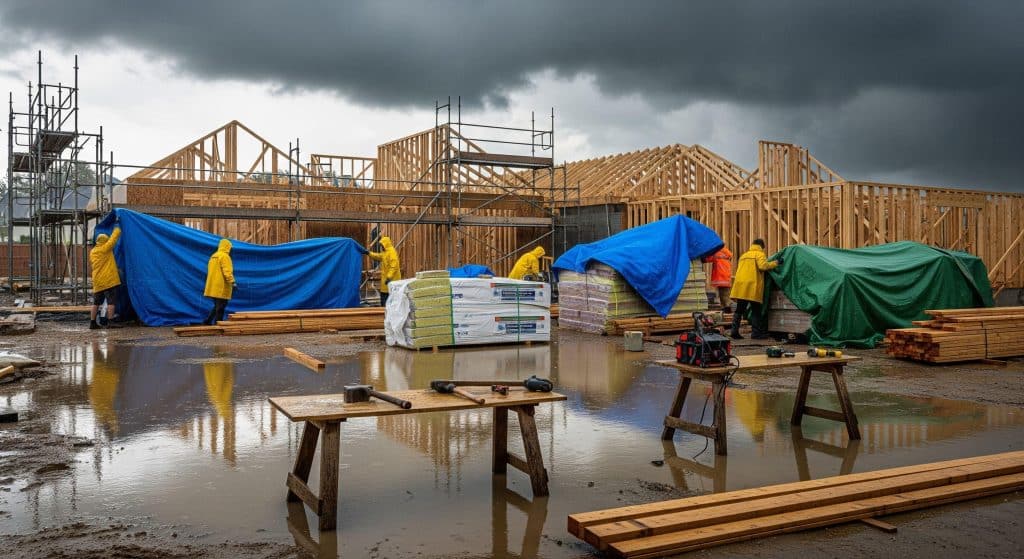
Weather delays cost time and money:
- Work stops during heavy rain.
- Materials must be covered and protected.
- Crews need to reschedule visits.
- Your home stays exposed longer.
Roofing in rain creates more problems than it solves. Wait for dry weather to protect your investment and ensure quality work.
Protective Measures Roofers Take
Professional roofers use several methods to protect your home during installation. These protective measures help prevent damage and keep work sites safe during unexpected weather.
| Measure | Details |
|---|---|
| Tarping |
Cover exposed areas with waterproof tarps. Secure tightly to prevent rain until installation is complete. |
| Drying In |
Apply temporary waterproof layers (underlayment, membranes). Protect the roof until the final materials are applied. |
| Weather Monitoring |
Check weather forecasts frequently. Adjust work and secure materials as needed. |
| Safety Protocols |
Use safety gear, secure tools, and inspect equipment. Keep emergency plans and first aid ready on-site. |
Good roofers prepare for weather challenges before they happen. These protective steps keep your home dry, prevent structural damage, and ensure workers stay safe during roof installation projects.
Homeowner Rain Preparation Tips
As a homeowner, you play an essential role in preparing for potential weather delays during your roof project. These simple steps help protect your property and ensure smooth communication with your contractor.
1. Stay Informed
Check weather forecasts daily leading up to your installation date. Use reliable weather apps or local news sources for accurate predictions.
Share any concerning weather alerts with your roofing contractor immediately. Plan indoor activities for days when work might be delayed by rain.
2. Prepare Your Home
Move furniture and valuables away from areas directly under the roof work. Cover items with plastic sheeting for extra protection against potential leaks.
Clear gutters and downspouts to ensure proper water drainage around your home. Remove outdoor furniture or decorations that might blow around in storms.
3. Maintain Communication
Keep your contractor’s phone number easily accessible throughout the project. Respond quickly to calls or texts about weather updates and schedule changes.
Ask questions about protective measures being taken during delays. Request regular updates on project timeline adjustments resulting from weather conditions.
4. Understand the Warranty
Review your roofing contract before work begins to understand weather-related coverage. Confirm that your warranty includes protection against rain damage during the installation process.
Inquire about additional coverage for extended delays resulting from multiple storm systems. Keep all warranty documentation in a safe, dry place.
Conclusion
Rain during roof installation doesn’t have to become a homeowner’s worst nightmare. I’ve walked you through the key risks, immediate response protocols, and protective measures that separate professional contractors from the rest.
The strategies I’ve shared, from proper tarping techniques to effective communication with your roofing team, will help you handle weather delays with confidence. Remember, quality roofing work can’t be rushed.
When contractors prioritize safety and proper installation over speed, you get a roof that protects your home for decades. Take time to review your warranty coverage and prepare your home before installation begins.
Ready to start your roofing project? Use these rain management strategies to ensure your investment stays protected, no matter what Mother Nature throws your way.
Frequently Asked Questions
What Happens if A New Under Roof Gets Wet?
Wet underlayment can lead to mold growth, wood rot, and structural damage. Replace any soaked materials immediately before installing the final roofing to prevent long-term problems.
Is Plywood Ruined if It Gets Wet?
Plywood isn’t always ruined by water. Light moisture can dry out safely. However, soaked plywood may warp, delaminate, or develop mold and should be replaced.
Does Water Get Under Roof Shingles?
Yes, water can get under shingles through wind-driven rain, ice dams, or damaged seals. Proper underlayment and flashing help prevent water from reaching your roof deck.

